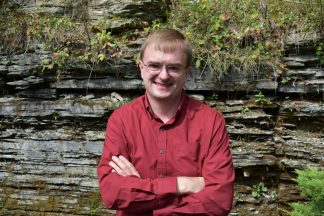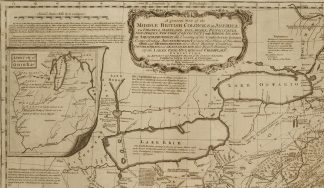By Allison Campbell-Jensen
Chad Anderson became interested in the history of indigenous people of North America because of the way, despite evidence, Europeans stopped seeing them. A professor of history at Hartwick College in New York State, Anderson will present virtually the James Ford Bell Lecture, “Hidden in Plain Sight: Stories of Indigenous Power in Early American Cartography,” Oct. 7, 7-9 p.m.
“This year’s lecture aligns with a current initiative at the Bell, and in the Libraries more generally, to make indigenous peoples more visible in the collection,” says Marguerite Ragnow, Curator of the James Ford Bell Library. “Our fall exhibit, Hidden in Plain Sight: Recovering “Lost Voices” in the Bell Collection, introduces this effort for Native Americans, as well as for enslaved peoples and women around the globe.” It runs from Oct. 3 through Dec. 21 in Elmer L. Andersen Library.
About the event
James Ford Bell Lecture Oct. 7, 7-9 p.m., Virtual presentation Professor Chad Anderson presents “Hidden in Plain Sight: Stories of Indigenous Power in Early American Cartography.”
While researching the early American republic, Anderson says, he noted that “popular culture and everyday people imagined indigenous people as vanishing or not having a future in American history.” He was researching the frontier of the time in New York State and noted that people moving west would happen upon a clearing and wonder how it came to be.
“I wondered why they missed the obvious,” he says. “That was obviously a Haudenosaunee [Iroquois Six Nations] village.”
He became fascinated by how significant Native North America was during Colonial times and the early part of U.S. history. Historians today talk about “how much of the continent remained Indian country for a very long time,” Anderson says. “Even when we are talking about the American Revolution, most of the European Americans are living in a small slice of land along the East Coast.”
The importance of the Iroquois
What is now upstate New York was one of the most significant places in the Colonial era. Anderson explored the creation, destruction, appropriation, and enduring legacy of the homelands of the Haudenosaunee in his book “The Storied Landscape of the Iroquoia.”
“That book is about places and their associated stories of settlements, stories of military victories, and of ancient civilizations, all this becomes part of not just Native culture but also early American culture,” he says.
The British, rulers of North American colonies at the time, saw the Iroquois, as exceptionally powerful leaders among the indigenous nations, so they sought their help in managing Native affairs.
“Whenever the British need something to do with Native North America, they are usually trying to get the Iroquois involved in whatever they are up to,” Anderson says. Starting in the 1670s, they developed relationships, a Covenant Chain, with the Iroquois that lasted into the Revolutionary era.
It was not an alliance exactly, Anderson says, and each partner brought their own intentions to it. Still, the Iroquois Six Nations, particularly the Mohawk, were among the central players of the time.
Indigenous peoples and the environment
As historians and anthropologists look at environmental history in North America, many of them today seek to discredit the myth that indigenous people lived at one with a pristine nature, that they had no effect on the landscape. This romanticized view could belie indigenous people’s efficacy and importance — and promote the false idea that only Europeans created settlements.
“There’s this whole world that exists — it exists largely on Native terms, in terms of who’s settling and what that means,” Anderson says. “It’s an important part of reminding people, yes, the continent was not empty, but also that Native people had modified it, and they had modified it in important ways that were not just important to indigenous people but also important to the struggle for empire and where power lies in North America as well.”
The stories maps tell
Maps will illuminate those stories of power in Anderson’s presentation. Most of the maps he will discuss are from the Bell Library’s collection.
“Some of the more famous maps can be almost absurd in how confident they are in asserting claims of empire at this time, but that confidence is hiding weakness,” he says. “It’s hiding weakness in how much Native North America still matters in terms of empire in the middle of the 18th century.”
He will offer the audience a fresh framework with which to interpret the maps.
“What I really want to do is take a lot of the fascinating scholarship that historians have about Native power and how important Native land was and indigenous power in the Americas,” Anderson says, “and use some of those insights to find stories on the maps.”
And so to reveal what is hidden in plain sight.
Event details
James Ford Bell Lecture Oct. 7, 7-9 p.m., Virtual presentation
Professor Chad Anderson presents “Hidden in Plain Sight: Stories of Indigenous Power in Early American Cartography.”






